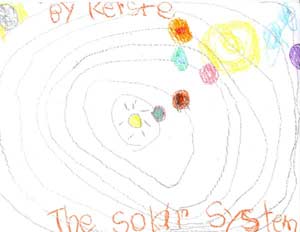 |
|
Question (submitted by Jack Raiden): will spaceships float?
Answer (submitted by Glenn) : Space capsules (and steel ships) float because of "displacement". "Trapped
air" has nothing to do with it.
Experiment: You will need a bit of tin foil, and a glass of water. Take the
tin foil, about one inch square, and form a hull with it: a nice, wide body
canoe with a pinched, watertight bow and stern, and gunwales (hull's edges)
at least a pinky's width apart. Place small metal boat in glass of water,
and observe two things:
1. The metal floats without "trapping" air.
2. The mass of the boat is spread out over a small amount of water. The hull
has "displaced" this water, and, if you could measure this mass of water,
you would find that it is equal to the mass of the boat in its present form:
thus, a balance has been achieved.
If you took this small boat out of the water, and crumpled it into a small
steel ball without air pockets, it will immediately sink when returned to
the water. The foil's mass has remained the same, but its area is much
smaller. That is, it takes up much less space, thus "displacing" much less
water.
When an object "moves aside" (displaces) water equal to it's mass, it will
float. That is why the space capsules that successfully landed in the ocean
did not immediately sink. Trapped air was not keeping it afloat.
Question : How
can we see Venus at night when it's closer to the
sun than us?
Answer (submitted by Glenn) : An Experiment (you will need your Mom & Dad to help):
The three of you should stand in a triangle, with you facing your Dad,
and your Mom to your left, somewhere between your Dad and you, but off to
the side.
Your Dad will be the Sun, your Mom will be Venus, and you will be the
Earth.
Face your Dad, and raise your arms up, flat with the floor, and
pointing in
opposite directions. Pretend your arms are the horizon. Everything in
front
of your arms you can see, because they are above the horizon.
Everything
behind your arms you cannot see, because they are below the horizon.
When you are facing your Dad, it is just like Noon time, with the Sun
overhead.
The Earth rotates, so you will have to start turning, too, towards your
left. Your right hand should move towards your Dad, and your left hand
should move away from him. When you are pretending that your hands mark
the
horizon, you will see that soon your right hand is pointing toward's
your
Dad: this is Sunset! If you keep turning, your hand will be past your
Dad,
the Sun has now set, and it is nighttime, because the Sun is behind the
horizon.
When your Mom (Venus) is still in front of your hand, and your Dad
(Sun) is
behind your hand, you can see how sometimes Venus can be ABOVE our
horizon,
even if the Sun is BELOW our horizon.
This is why sometimes Venus is visible to us after the Sun goes down.
Venus orbits the Sun just like Earth, only closer: you already know
that. If
your Mom orbits around your Dad, moving from his right to his left, and
if
you keep turning, then you can see why sometimes we can see Venus just
before the Sun comes up, just like sometimes either of your hands can
be
between your Mom and Dad.
|


